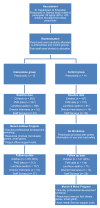Munch and Move: evaluation of a preschool healthy eating and movement skill program
- PMID: 21047434
- PMCID: PMC2988057
- DOI: 10.1186/1479-5868-7-80
Munch and Move: evaluation of a preschool healthy eating and movement skill program
Abstract
Background: Early childhood services have been identified as a key setting for promoting healthy eating and physical activity as a means of preventing overweight and obesity. However, there is limited evidence on effective nutrition and physical activity programs in this setting. The purpose of this study was to evaluate Munch and Move, a low-intensity, state-wide, professional development program designed to support early childhood professionals to promote healthy eating and physical activity among children in their care.
Methods: The evaluation involved 15 intervention and 14 control preschools (n = 430; mean age 4.4 years) in Sydney, New South Wales, Australia and was based on a randomised-control design with pre and post evaluation of children's lunchbox contents, fundamental movement skills (FMS), preschool policies and practices and staff attitudes, knowledge and confidence related to physical activity, healthy eating and recreational screen time.
Results: At follow up, FMS scores for locomotor, object control and total FMS score significantly improved by 3.4, 2.1 and 5.5 points more (respectively) in the intervention group compared with the control group (P < 0.001) and the number of FMS sessions per week increased by 1.5 (P = 0.05). The lunchbox audit showed that children in the intervention group significantly reduced sweetened drinks by 0.13 serves (i.e., 46 ml) (P = 0.05).
Conclusion: The findings suggest that a low intensity preschool healthy weight intervention program can improve certain weight related behaviours. The findings also suggest that change to food policies are difficult to initiate mid-year and potentially a longer implementation period may be required to determine the efficacy of food policies to influence the contents of preschoolers lunchboxes.
Figures
References
-
- Branta C, Haubenstricker J, Seefeldt V. Age changes in motor skills during childhood and adolescence. Exercise & Sport Sciences Reviews. 1984;12:467–520. - PubMed
-
- Australian Bureau of Statistics. Year Book Australia, 2008. Canberra, Australian Bureau of Statistics; 2008. [1301.0]
LinkOut - more resources
Full Text Sources
Miscellaneous



